1.7 Energy, work and power
1.7.1 Energy
Energy may be stored as kinetic, gravitational potential, chemical, elastic (strain), nuclear, electrostatic and internal (thermal)
Energy Stores and Transfers
Energy Stores: Energy can be stored in various ways:
| Form of Energy | Examples |
|---|---|
| Kinetic Energy: The energy an object possesses due to its motion. | A moving car has kinetic energy. |
| Gravitational Potential Energy: Energy stored due to an object’s position in a gravitational field. | Water stored in a reservoir at a height has gravitational potential energy. |
| Chemical Energy: Stored in the bonds between atoms and molecules. | Energy in food, batteries, or fuels like gasoline. |
| Elastic (Strain) Energy: Stored in objects when they are stretched or compressed. | Energy in a stretched rubber band or compressed spring. |
| Nuclear Energy: Energy stored in the nucleus of atoms. | Energy released during nuclear fusion in the sun. |
| Electrostatic Energy: Energy stored due to the position of charged particles. | Energy between two charged objects, like in a capacitor. |
| Internal (Thermal) Energy: Energy stored in an object due to the random motion of its particles. | Heat energy in a hot cup of coffee. |
Energy Transfers Between Stores
Energy can be transferred between stores in several ways:
- Mechanical Work (Forces):
- Energy can be transferred between stores in several ways:
- Example: Pushing a box across a floor transfers energy from chemical (muscles) to kinetic energy of the box.
- Electrical Work (Electrical Currents):
- Energy transferred by an electric current.
- Example: In a battery-powered device, chemical energy in the battery is transferred as electrical energy to power the device.
- Heating (Thermal Transfer):
- Energy transferred through heating can increase an object’s thermal store.
- Example: When you heat water in a kettle, electrical energy is transferred to the thermal energy of the water.
- By Waves (Electromagnetic, Sound, and Others):
- Energy transferred through waves like light, sound, or microwaves.
- Example (Electromagnetic): The sun transfers energy to Earth by radiation (light waves).
- Example (Sound): Vibrating guitar strings transfer mechanical energy as sound waves.
Principle of Conservation of Energy
Principle of Conservation of Energy
Energy cannot be created or destroyed, only transferred from one store to another. The total energy in a closed system remains constant.
Example 01:
Simple Examples of Conservation of Energy:
1. A Pendulum:
At the highest point in its swing, the pendulum has maximum gravitational potential energy.
As it swings down, gravitational potential energy is transferred to kinetic energy.
At the lowest point, the pendulum has maximum kinetic energy.
As it rises again, kinetic energy is transferred back to gravitational potential energy.
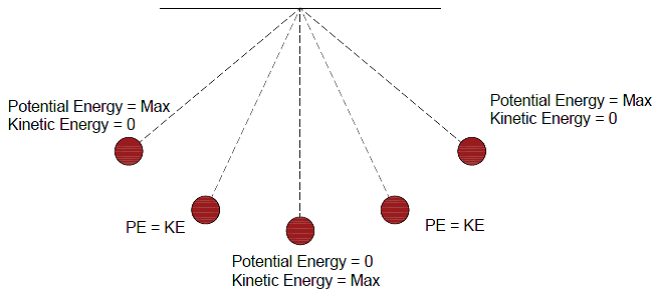
Note: that in a real pendulum the bob’s swing will become slightly lower with each swing, because some energy is lost (dissipated, ‘wasted’) through heating, due to air resistance.
Example 02:
2. Roller Coaster:
At the max height of the track, a roller coaster has max gravitational potential energy and zero kinetic enery (V = 0m/s)
As it descends, this energy converts into kinetic energy.
Some energy is also lost as thermal energy due to friction.
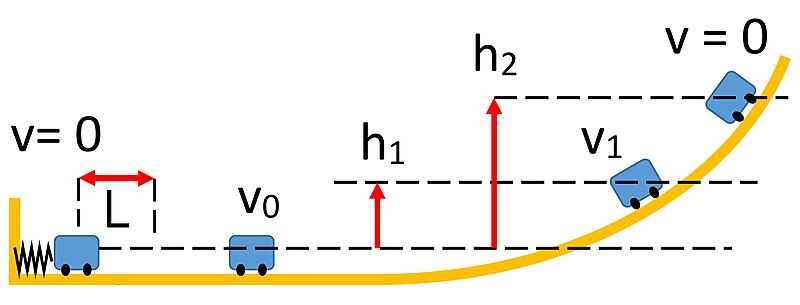
Flow Diagrams for Energy Transfers
Flow diagrams show how energy is transferred between different stores.
Example 01:
Battery-Powered Lamp
Battery (Chemical Energy) → Lamp (Electrical Energy) → Light + Heat (Electromagnetic + Thermal Energy)
In this example, chemical energy in the battery is transferred to electrical energy, which powers the lamp. The lamp emits light (electromagnetic energy) and also produces heat.
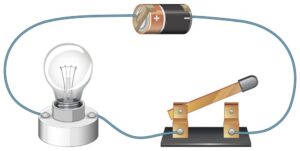
Example 02:
Ball Falling
Gravitational Potential Energy → Kinetic Energy → Thermal Energy (due to air resistance)
A ball falling from a height converts gravitational potential energy into kinetic energy as it accelerates. Some of the energy is transferred to the surroundings as thermal energy due to air resistance.

Applying Conservation of Energy to Flow Diagrams
When interpreting flow diagrams:
The total energy at the start is equal to the total energy at the end.
- Energy may be lost to surroundings (typically as heat), but it is not destroyed.
Example: Electrical Appliance
- Electrical Energy → Useful Energy (Light) + Wasted Energy (Heat)
In an electrical device like a lightbulb, electrical energy is mostly transferred into light energy (useful) and some into thermal energy (wasted).
Example of energy transferred during an event
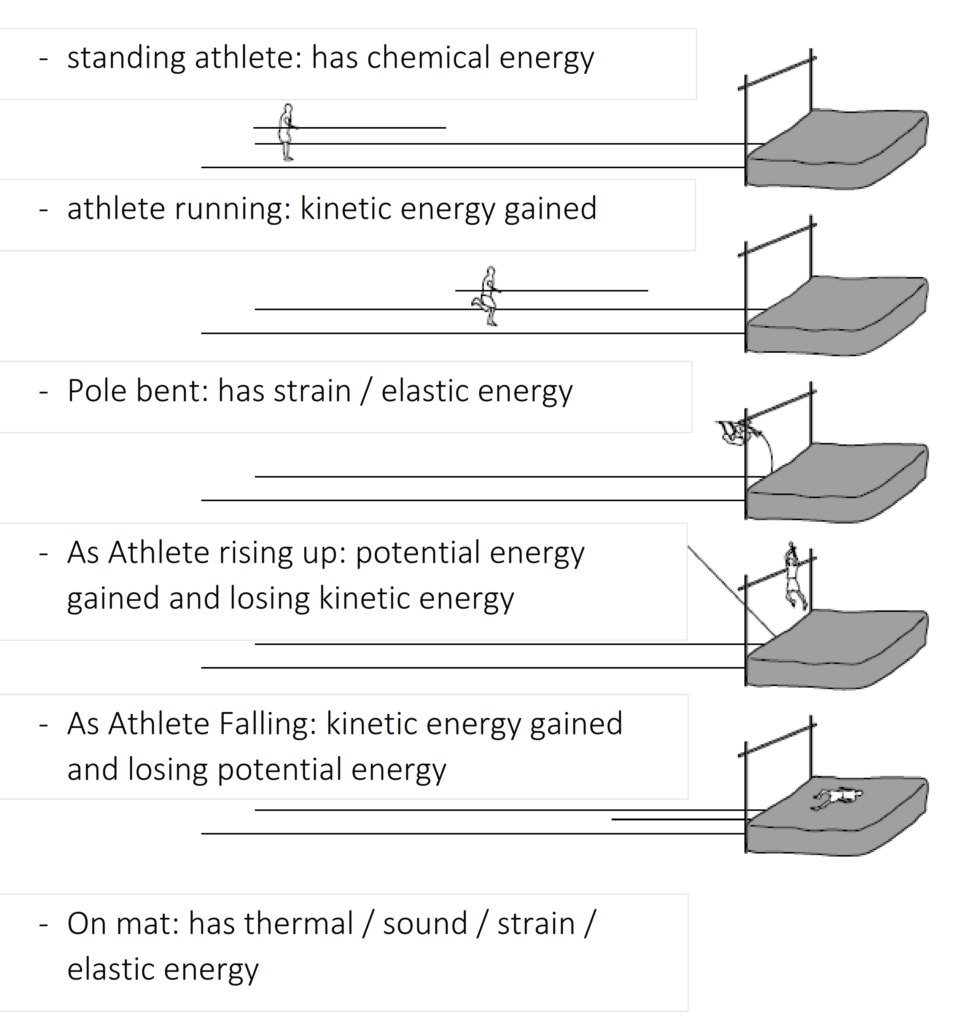
– kinetic energy :
kE = 1/2 m v2
‘m’ is the mass (Kg)
‘v’ is the velocity
– Gravitational Potential Energy :
GPE = mg∆h
‘m’ is the mass (Kg)
‘g’ is the gravity
‘∆h’ is the change in height
1.7.2 Work
Work is done whenever a force moves something over a distance.
The greater the force, the more work is done. The greater the distance moved, the more work is done.
W = Fd = ΔE
‘W’ is the work done and the unit is Joule (J),
‘F’ is the force,
‘d’ is the distance moved,
‘ΔE’ is the energy transferred.
Example 01:
Figure below shows a fork-lift truck lifting a crate on to a high shelf in a warehouse.

The fork-lift truck lifts a crate of weight 640 N through a vertical distance of 3.5 m in 4.0 s.
a). Calculate the useful work done in lifting the crate.
W.d = Fd
W.d = 640 x 3.5 = 2240J
b). Not all of the energy supplied is used usefully in lifting the crate.
Suggest two mechanisms by which energy is wasted.
Electrical heating, As Friction, W.d. lifting supports, As Sound energy
1.7.3 Energy resources
Useful Energy Generation and Electrical Power Sources
1. Chemical Energy Stored in Fossil Fuels (Coal, Oil, Natural Gas)
Fossil fuels are burned to release chemical energy stored within them. This energy is used to heat water, which turns into steam and drives a turbine connected to a generator, producing electricity.
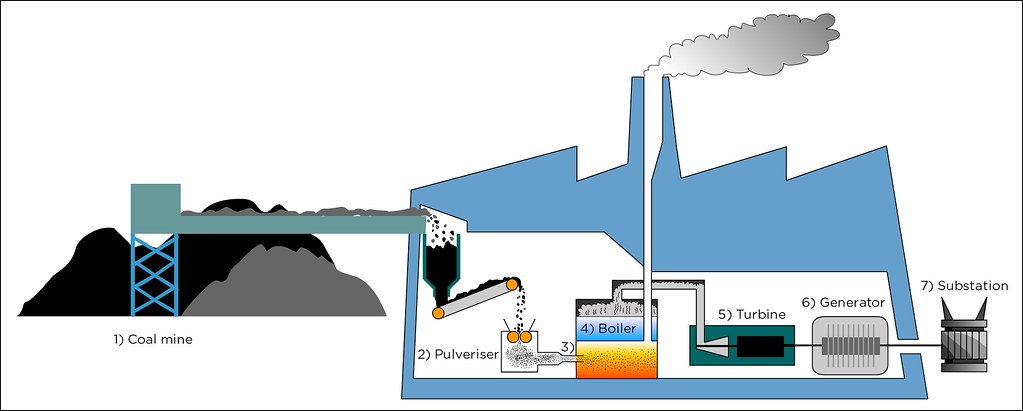
Process:
– Boiler: Fossil fuels are burned in a boiler to heat water.
– Turbine: Steam produced drives the turbine.
– Generator: The turbine turns a generator, producing electricity.
| Advantages: | Disadvantages: |
|---|---|
| Reliable and efficient for large-scale energy production. | Non-renewable (finite resources). |
| Widely available infrastructure. | Significant environmental impact (greenhouse gas emissions, air pollution). |
| Mining and drilling can harm ecosystems. |
2. Chemical Energy Stored in Biofuels (Biomass, Ethanol)
Biofuels are renewable sources derived from organic matter such as plants. The chemical energy is released through combustion or biological processes, such as fermentation, to produce electricity.
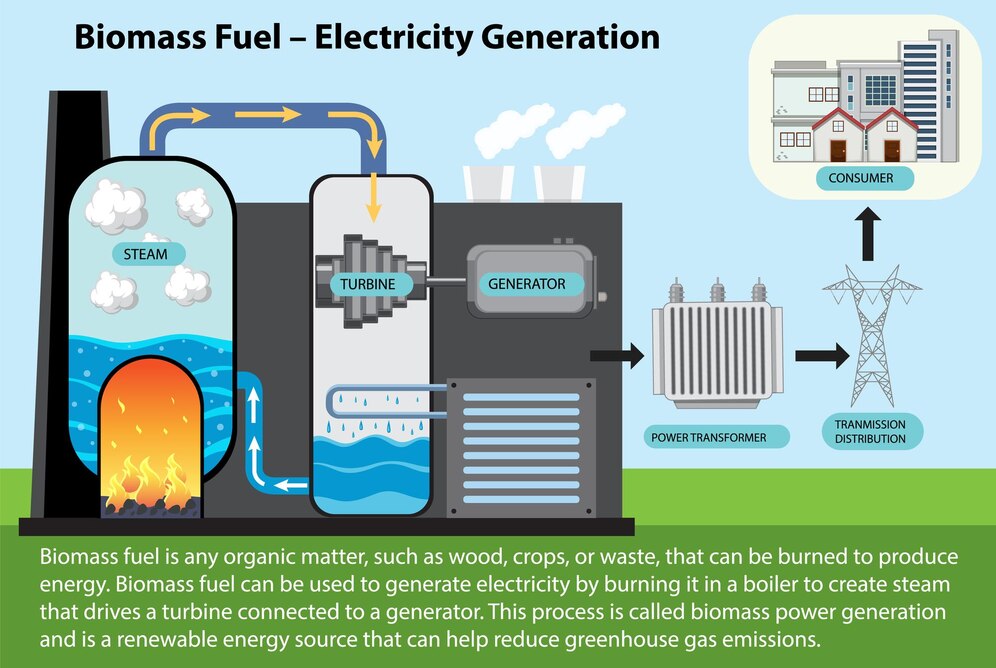
Process:
– Boiler: Biomass is burned to heat water, producing steam.
– Turbine & Generator: Steam turns the turbine, which drives a generator
| Advantages: | Disadvantages: |
|---|---|
| Renewable as plants can be grown again. | Requires large amounts of land and water. |
| Lower carbon emissions compared to fossil fuels. | Can lead to deforestation and habitat loss. |
| Can reduce waste if derived from organic waste. | May still emit CO₂ when burned. |
3. Water: Energy from Waves, Tides, and Hydroelectric Dams
Water power can be harnessed in various ways:
Hydroelectric Dams: Water stored behind dams is released, driving turbines.
Tidal Energy: As tides rise and fall, water movement spins turbines.
Wave Energy: The motion of waves can drive generators through mechanical devices.

Process:
– Turbine & Generator: Moving water turns the turbine, which powers a generator.
| Advantages: | Disadvantages: |
|---|---|
| Renewable and produces no emissions. | High environmental impact (habitat disruption, fish migration affected in dams). |
| Reliable in areas with consistent water flow (dams and tides). | Tidal and wave energy can be less predictable. |
| Large-scale production potential (especially dams). | High initial costs and limited suitable locations. |
4. Geothermal Resources
Geothermal energy harnesses heat from beneath the Earth’s surface. This heat is used to produce steam that drives turbines connected to generators.
Geothermal energy harnesses heat from beneath the Earth’s surface. This heat is used to produce steam that drives turbines connected to generators.
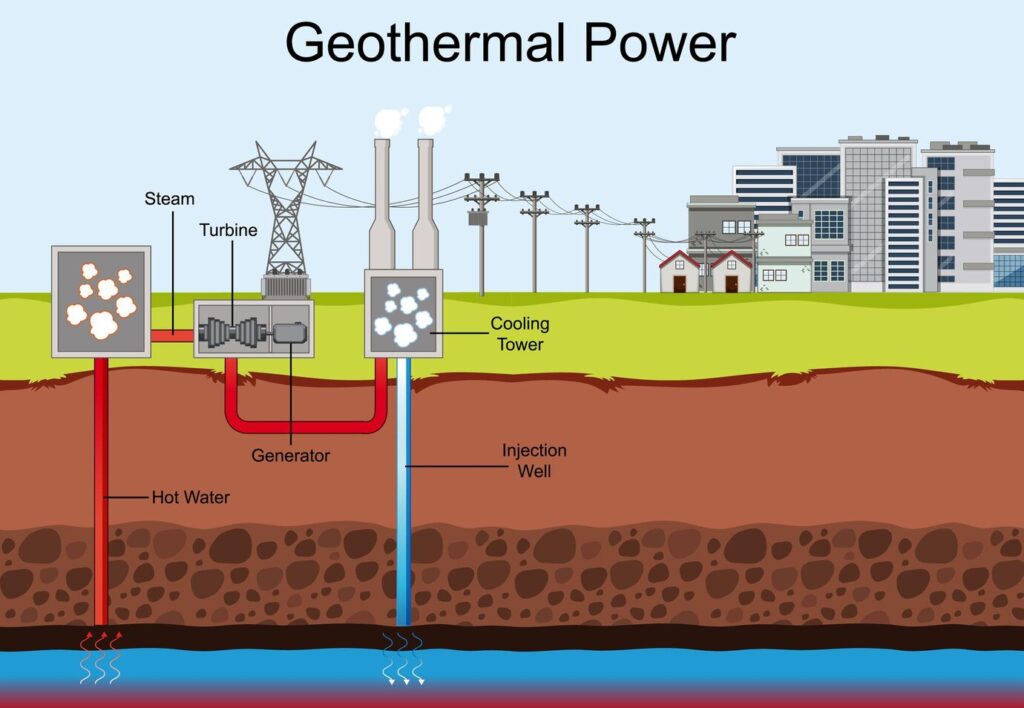
Process:
– Boiler: Water is heated by geothermal heat.
– Turbine & Generator: The steam from heated water drives turbines to generate electricity.
| Advantages: | Disadvantages: |
|---|---|
| Renewable and reliable, especially in geologically active areas. | Limited to regions with geothermal activity (volcanic or tectonic zones). |
| Low environmental impact and emissions. | High initial costs for drilling and infrastructure. |
| Potential release of harmful gases from beneath the Earth. |
5. Nuclear Fuel
Nuclear energy is produced by splitting atoms of uranium in a process called nuclear fission. This releases massive amounts of heat energy, used to produce steam that drives turbines and generates electricity.
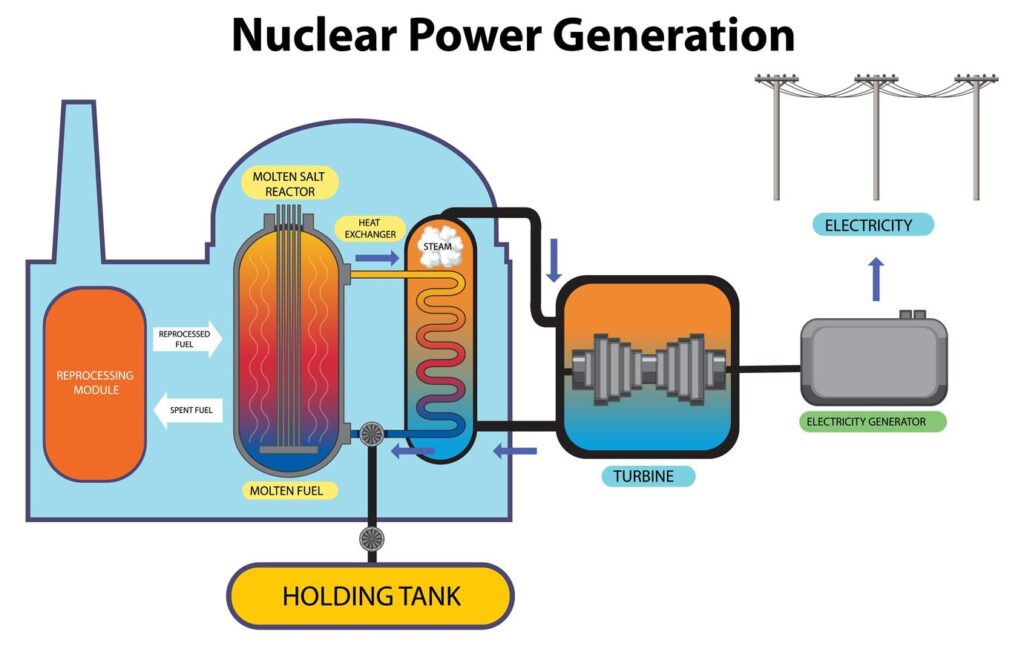
Process:
– Reactor: Nuclear fission occurs in the reactor, releasing heat.
– Boiler: Heat turns water into steam.
– Turbine & Generator: Steam drives turbines, generating electricity.
| Advantages: | Disadvantages: |
|---|---|
| Very efficient and can produce large amounts of energy. | Non-renewable (limited supply of uranium). |
| Low greenhouse gas emissions during operation. | High initial cost |
| Produces radioactive waste, which requires safe long-term storage. | |
| Risk of accidents and nuclear disasters (e.g., Chernobyl, Fukushima). |
6. Light from the Sun to Generate Electrical Power (Solar Cells)
Solar cells, also known as photovoltaic (PV) cells, convert sunlight directly into electrical energy through the photovoltaic effect.

Process:
– Solar Cells: Sunlight is absorbed by semiconductor materials (e.g., silicon), which generate electrical current.
| Advantages: | Disadvantages: |
|---|---|
| Renewable and environmentally friendly (no emissions). | Dependent on sunlight (not reliable in cloudy regions or at night). |
| Can be used in remote locations without power grids. | Requires large surface areas to produce significant energy. |
| Expensive initial installation. |
7. Infrared and Electromagnetic Waves from the Sun: Solar Panels and Wind Energy
– Solar Panels for Heating Water: Solar panels capture infrared and other electromagnetic waves from the sun to heat water for domestic or industrial use.
– Wind Energy: Wind energy is generated as the Sun’s heat causes atmospheric movements, creating wind that spins turbines connected to generators.

Process:
– Turbine & Generator: Wind turns the turbine, which drives a generator.
| Advantages: | Disadvantages: |
|---|---|
| Renewable and produces no emissions. | Wind is not constant, leading to unreliable energy supply. |
| Can be used in windy areas on a large or small scale. | Can impact wildlife (birds) and local environments. |
| Noise and aesthetic concerns in populated areas. |
Efficiency of Energy Transfer
- Efficiency is a measure of how good a device or process is at transferring energy into a useful form.
- In any energy transfer, some energy is always lost (often as heat), and the remaining energy is the useful energy.
- Devices are more efficient when they transfer more energy into the form you want and lose less as wasted energy.
For example, an electric heater is almost 100% efficient because nearly all the electrical energy is converted into heat energy, which is useful. In contrast, a car engine is much less efficient because some of the energy is lost as heat and sound.
Radiation from the Sun as the Main Energy Source
The Sun is the main source of energy for most energy resources on Earth.
- Solar energy comes directly from the Sun’s light.
- Wind energy is driven by the Sun’s heat, which causes the movement of air.
- Hydroelectric power depends on the Sun’s heat driving the water cycle, moving water into rivers and dams.
- Biomass energy comes from plants, which grow using sunlight.
However, the energy from sources like geothermal, nuclear, and tidal doesn’t come from the Sun.
Nuclear Fusion in the Sun
- The Sun releases energy through nuclear fusion.
- In the Sun, hydrogen atoms fuse together to form helium. This process releases a huge amount of energy in the form of light and heat.
- This fusion process is what powers the Sun and provides the energy that reaches Earth.
Research into Nuclear Fusion for Electricity
- Scientists are researching how to use nuclear fusion to generate electricity on Earth.
- If successful, fusion could provide a clean and almost limitless energy source, because it uses hydrogen, which is abundant in water.
- However, it’s very difficult to control the high temperatures and pressures needed for fusion, so research is still ongoing.
Defining and Calculating Efficiency
- Efficiency tells us how well a device uses energy or power. It is expressed as a percentage (%) using the following formulas:
Efficiency (Energy):
\(\text{Efficiency} = \left( \frac{\text{Useful energy output}}{\text{Total energy input}} \right) \times 100\)
- This shows how much of the total energy put into a device is turned into useful energy.
Efficiency (Power):
\(\text{Efficiency} = \left( \frac{\text{Useful power output}}{\text{Total power input}} \right) \times 100\)
Example:
If a machine takes in 100J of energy but only produces 40J of useful energy, the efficiency would be:
\(\text{Efficiency} = \left( \frac{\text{40J}}{\text{100J}} \right) \times 100=40%\)
This means 40% of the input energy is useful, and the remaining 60% is wasted (often as heat).
1.7.4 Power
Power is the rate of doing work
The greater the work done in a given time, the greater the power. The shorter the time in which a given amount of work is done, the greater the power.
Unit of power is Watt (W)

Don’t know how to thank u. Really helpful work sir
Excellent web site you have here.. It’s difficult
to find high-quality writing like yours nowadays.
I really appreciate individuals like you! Take care!!
legendary notes